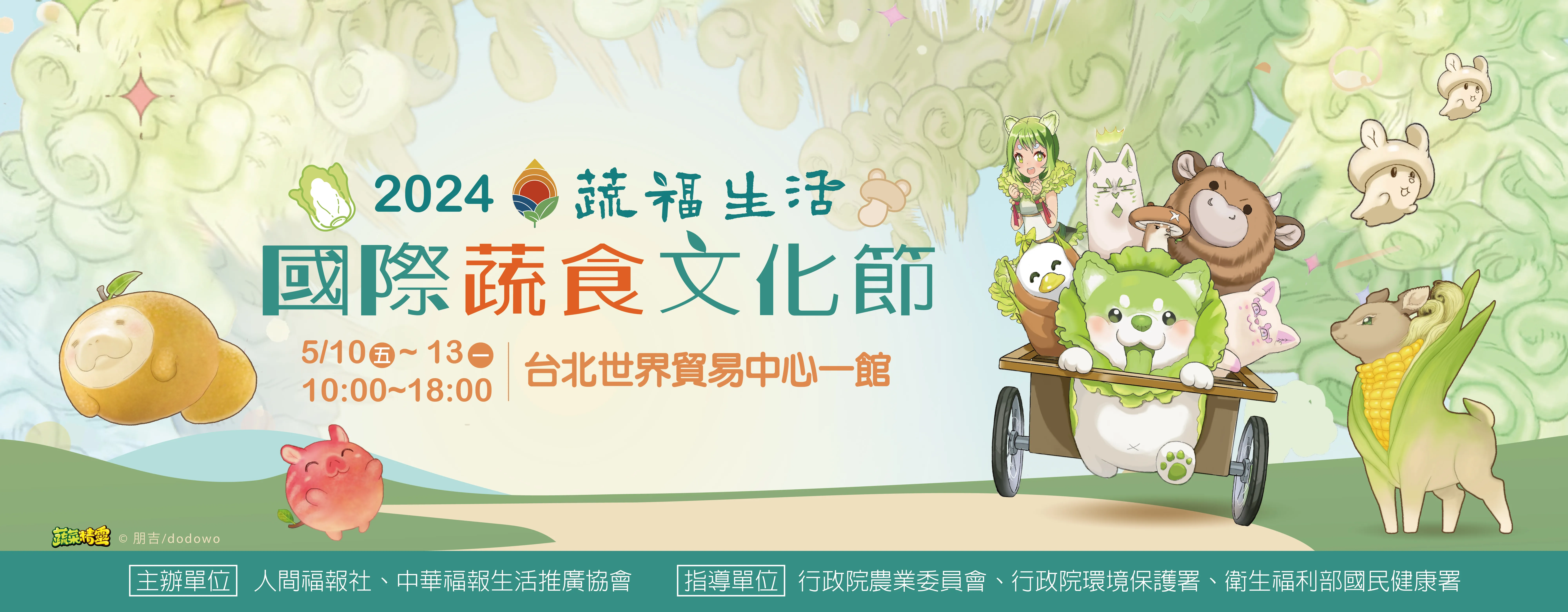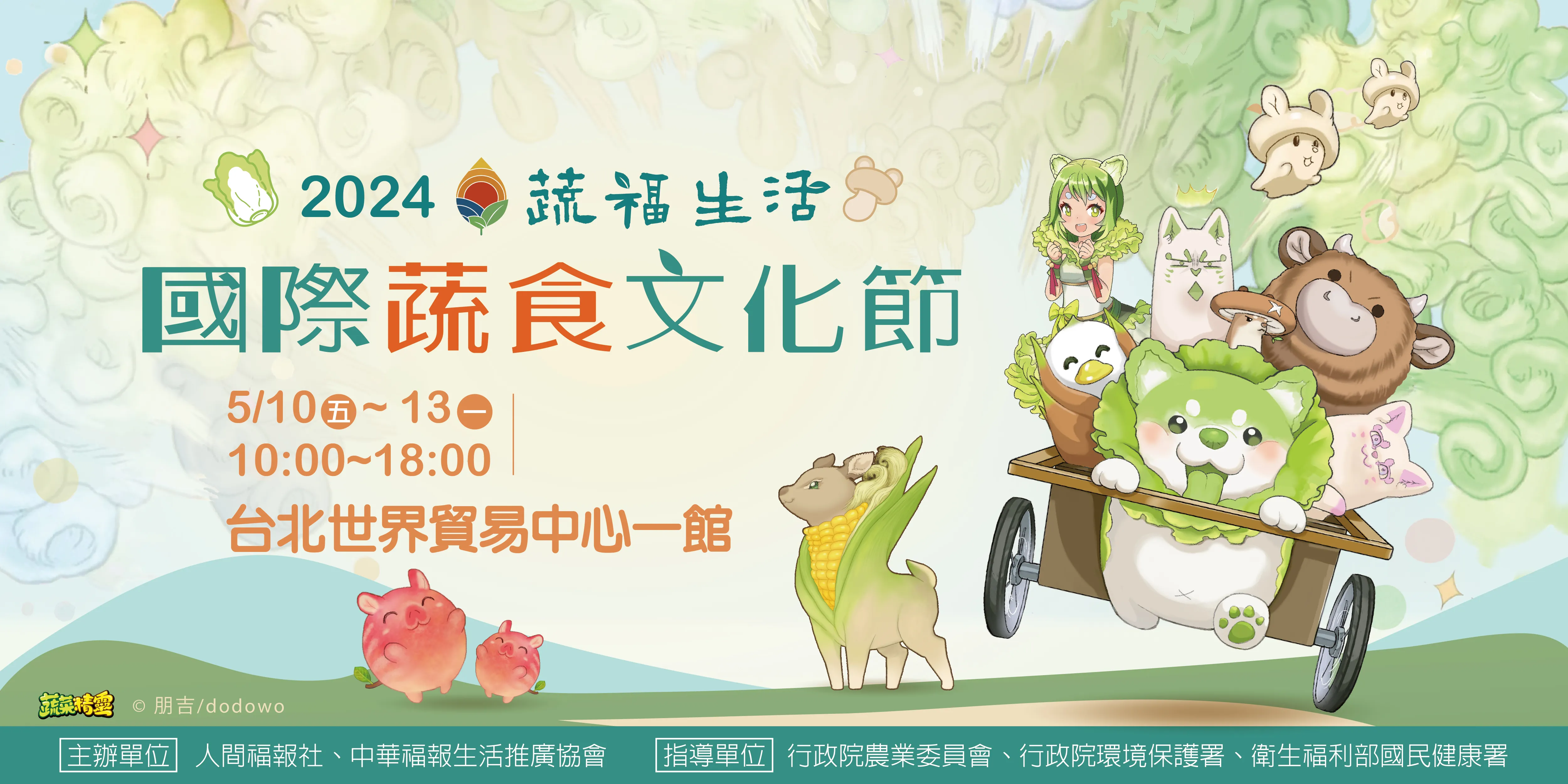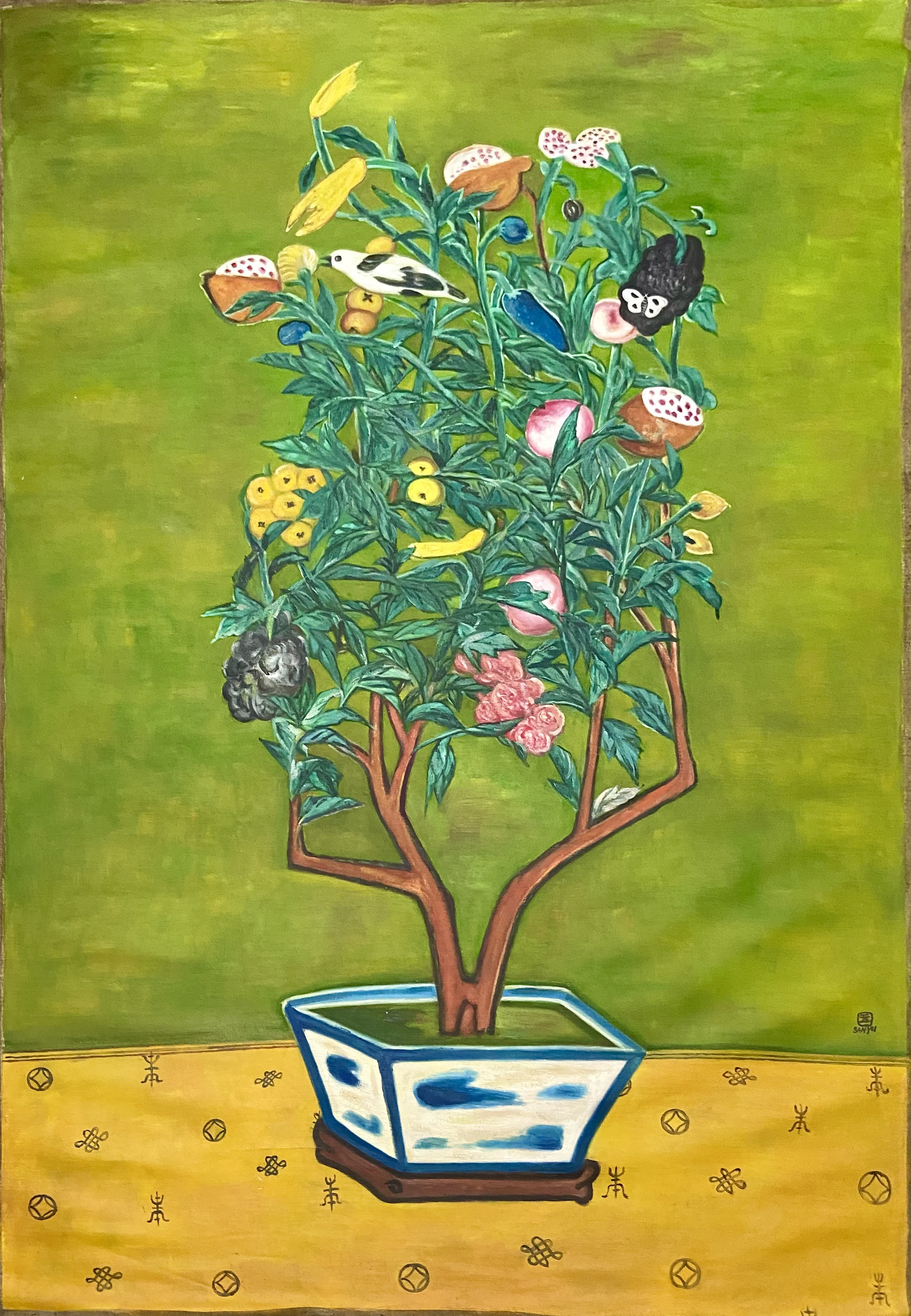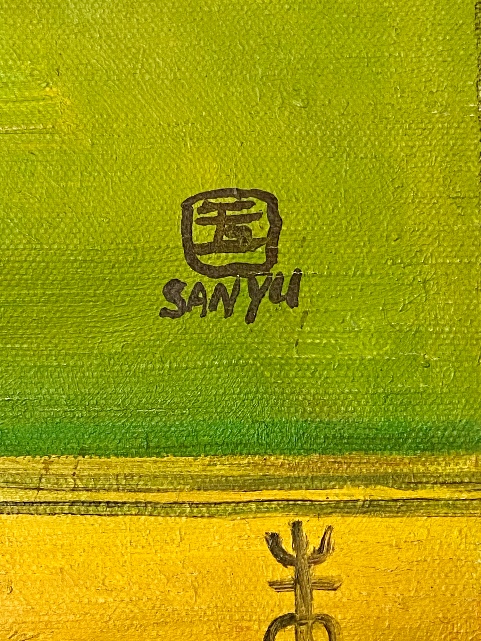


| 時代: | 西元1950年代 A.D. 1950s |
| 尺寸: | 長度:180 cm 寬度:121.5 cm (未含外框) Length:180 cm Width:121.5 cm |
| 質地: | 油畫布 Oil painting |
收藏人:謝明村先生
此幅常玉的‟盆中的果樹(120號)”為常玉的油畫靜物作品,此幅畫作花盆底部、枝幹部分、果實、花和葉子局部,稍微以書法性黑色系線條打邊,立體、色澤深淺不一的線條瀟灑十足,並納入山水圖畫的留白概念,整幅畫構圖簡約。此幅畫作以草綠色為背景、黃色為桌面,桌面上有古錢紋等中國式的紋飾,背景的草綠色深淺不同,隱約看得出背景下方應有畫過其他畫的痕跡,符合常玉在同一畫布上重複做畫的特性。色彩繽紛的枇杷、桃子和石榴等果實,搭配綠色的葉子、莖脈和褐色枝幹,果樹上有黑白相間的鳥及蝴蝶,種於白色、藍色的青花瓷花盆中,藉由些微色系深淺、陰影,襯托出整體的層次感。此畫是常玉慣用、油畫作畫方式最高境界的平塗法創作,以中國水墨寫意流暢的書法線條,融合西方野獸派的簡潔強烈特色,獨創辨識度高的繪畫風格,此幅局部顏料中即有脫落的毛筆痕跡。常玉性格灑脫,線條力道十足、不重複,即便平塗上色後遮蓋住線條,也不會再重複描線,厚實的平塗色塊搭配中國式的渲染方式,呈現出果實和葉子的立體感,是常玉畫作的重要特徵。此幅畫與財團法人立青文教基金會資料中的《盆中的果樹》畫作構圖雷同,惟立青文教基金會資料中的畫作是畫在木板且尺寸較小,此幅畫作尺寸較大且是畫在畫布上。此幅畫作所用之畫布含棉、麻,畫布微厚,為1950年代歐美常用之畫布,畫布後有年代久遠形成的黴斑,以及因年代久遠油畫顏料滲透的痕跡,且畫布已失去韌性、易脆,油畫顏料是常玉慣用以亞麻仁油調色、年代久會有黏性的顏料,而因早期保存環境不佳,讓此幅畫作有部分氧化現象。右下角有繪出的「玉」字圖章,以及羅馬拼音「SANYU」,為常玉油畫常用之落款,此幅為標準、正確之經典常玉畫作。
San Yu's "Fruit Trees in a Pot (No. 120)" is an oil painting depicting still life. The bottom of the flowerpot, branches, fruits, flowers, and leaves are outlined with calligraphy-like black lines, creating lively and three-dimensional lines with varying shades. The painting incorporates the concept of blank spaces from traditional landscape paintings, resulting in a simple composition. The background, painted in grass green, and the tabletop in yellow feature traditional Chinese patterns, such as ancient coin motifs. The varying shades of grass green in the background hint at traces of other paintings, consistent with San Yu's practice of repeatedly painting on the same canvas. The colorful fruits, including loquats, peaches, and pomegranates, along with green leaves, stems, and brown branches, are accompanied by black and white birds and butterflies on the fruit tree. The entire scene is set in a white and blue porcelain flowerpot. Subtle variations in color depth and shading enhance the overall sense of layering. This painting showcases San Yu's mastery of the flat application technique, blending the fluid lines of traditional Chinese ink painting with the concise and intense characteristics of Western Fauvism, creating a distinctive and recognizable painting style. Some brush marks, indicative of a brush, are visible in the pigments in certain areas.
San Yu's carefree personality is reflected in the powerful and non-repetitive strokes. Even after applying the flat colors that cover the lines, there is no attempt to re-outline. The thick, flat color blocks, combined with a Chinese-style shading technique, present a three-dimensional quality to the fruits and leaves, a significant feature of San Yu's artworks. The composition of this painting closely resembles a work titled "Fruit Trees in a Pot" in the archives of the Li Ching Cultural and Educational Foundation. However, the painting in the archives is on wood and smaller, while this painting is larger and on canvas. The canvas used in this artwork is a blend of cotton and linen, slightly thick, typical of the canvas used in Europe and America in the 1950s. The canvas exhibits mold spots formed over time, as well as traces of oil pigment permeation due to aging. The canvas has lost its flexibility and has become brittle, and there are signs of oxidation in some areas due to the use of linseed oil by San Yu, known for its stickiness over time. In the lower right corner, there is a drawn "玉" character seal and the Romanized signature "SANYU," a common signature in San Yu's oil paintings, indicating that this painting is a standard and authentic classic work by San Yu.

- 常玉‟青花盆中的粉菊(120號)” San Yu "Pink Chrysanthemums in a Blue and White Pot" (No. 120)
- 林風眠‟寶蓮燈”
- 林風眠油畫‟京劇關羽與趙雲(漢津口)” Mr. Lin Fengmian "Peking Opera: Guan Yu and Zhao Yun (Han Jin Gate)"
- 常玉‟紅底黃菊” San Yu "Yellow Chrysanthemums on Red Background"
- 林風眠油畫‟白蛇傳” Mr. Lin Fengmian "Legend of the White Snake"
- 常玉‟花團錦簇(120號)” San Yu "Abundance of Flowers" (No. 120)
- 常玉‟向陽白牡丹(120號)” San Yu " White Peonies Facing the Sun (No. 120)"
- 林風眠油畫‟大鬧天宮”Mr. Lin Fengmian "Great Uproar in Heaven"
- 常玉‟紅底盆菊(120號)” San Yu " Red-Based Chrysanthemums in a Pot (No. 120)"
- 常玉‟盆菊與蝶(120號)” San Yu "Chrysanthemums and Butterflies (No. 120)"
- 常玉‟青花盆中的粉菊(120號)” San Yu "Pink Chrysanthemums in a Blue and White Pot" (No. 120)
- 林風眠‟寶蓮燈”
- 林風眠油畫‟京劇關羽與趙雲(漢津口)” Mr. Lin Fengmian "Peking Opera: Guan Yu and Zhao Yun (Han Jin Gate)"
- 常玉‟紅底黃菊” San Yu "Yellow Chrysanthemums on Red Background"
- 林風眠油畫‟白蛇傳” Mr. Lin Fengmian "Legend of the White Snake"
- 常玉‟花團錦簇(120號)” San Yu "Abundance of Flowers" (No. 120)
- 常玉‟向陽白牡丹(120號)” San Yu " White Peonies Facing the Sun (No. 120)"
- 林風眠油畫‟大鬧天宮”Mr. Lin Fengmian "Great Uproar in Heaven"
- 常玉‟紅底盆菊(120號)” San Yu " Red-Based Chrysanthemums in a Pot (No. 120)"
- 常玉‟盆菊與蝶(120號)” San Yu "Chrysanthemums and Butterflies (No. 120)"
